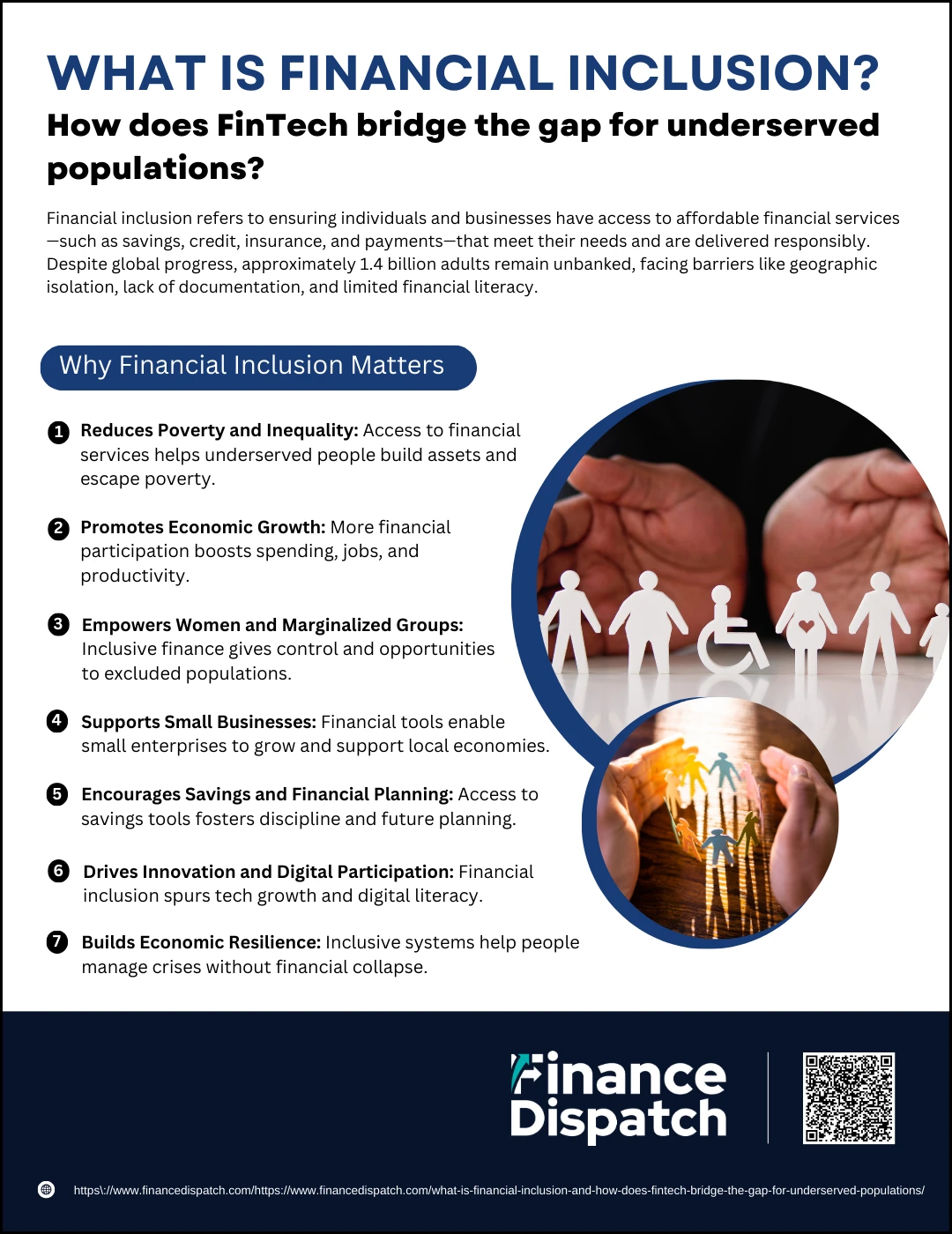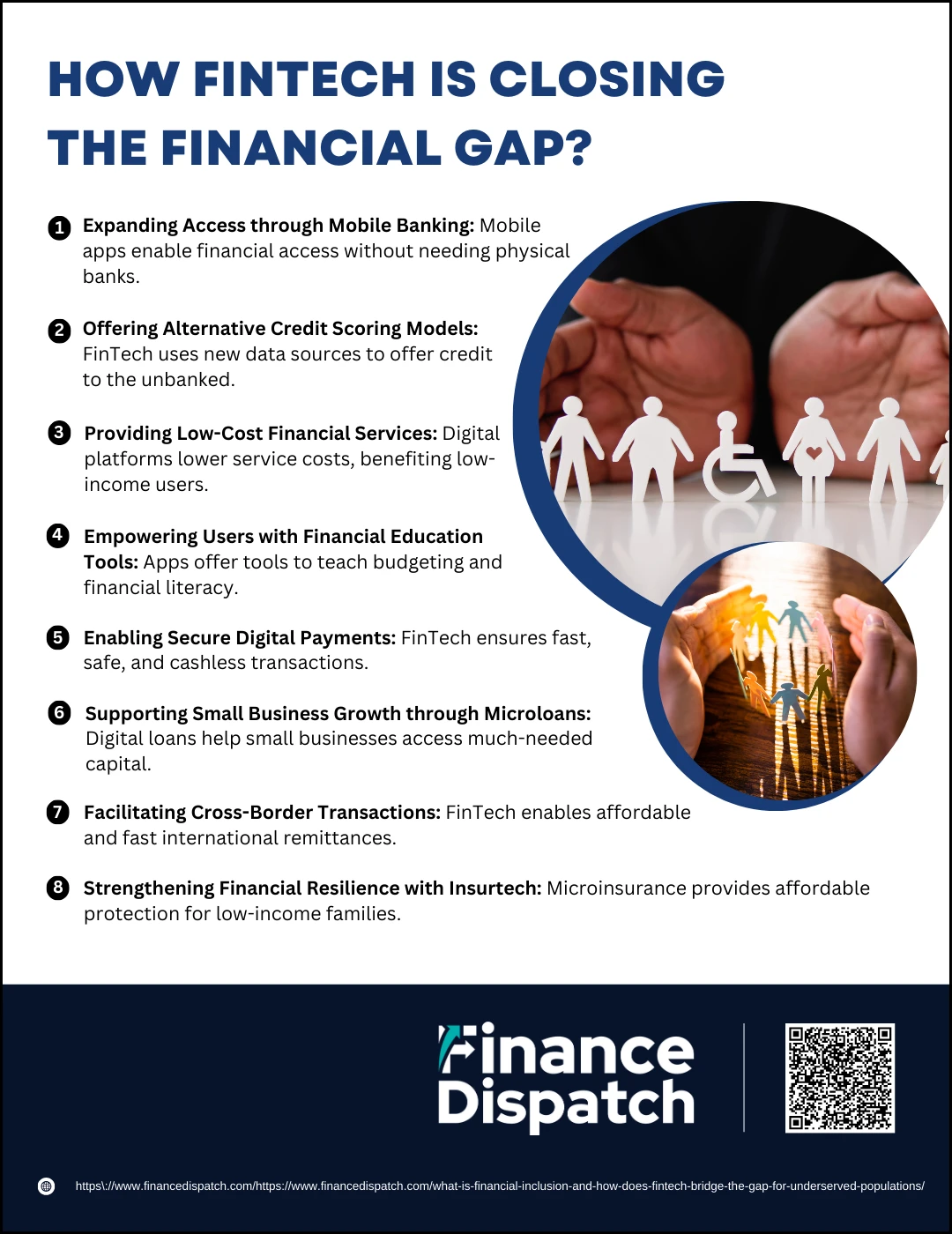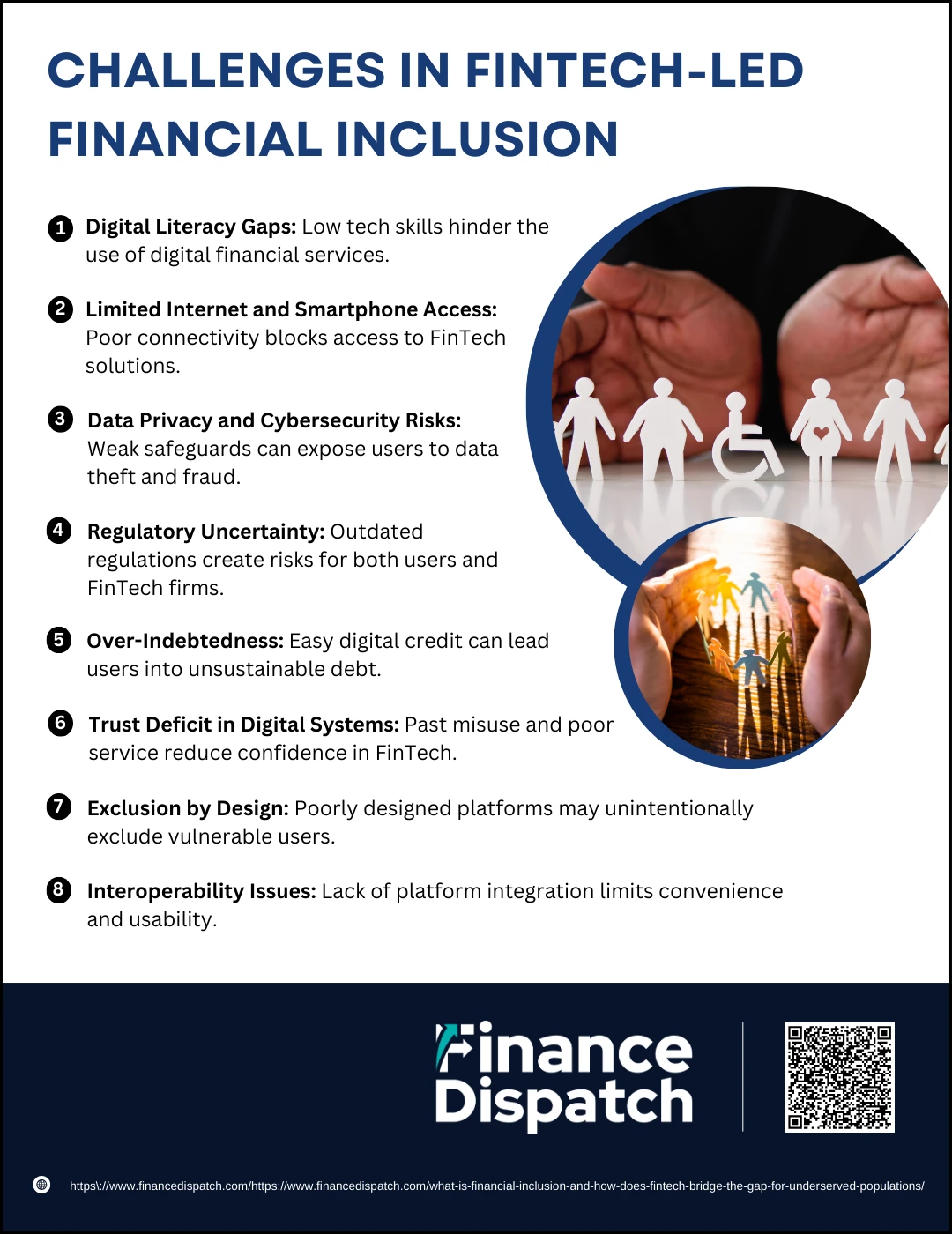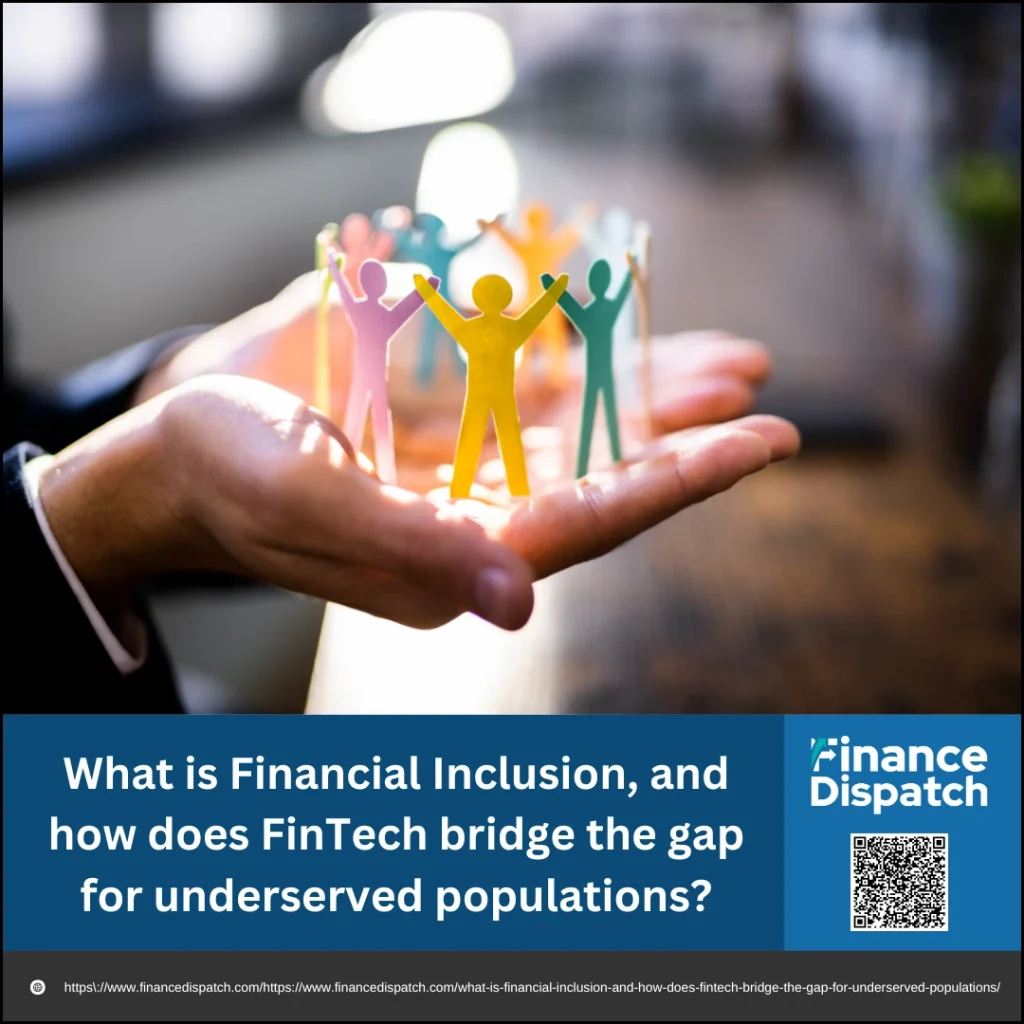In today’s rapidly digitizing world, access to financial services is no longer a luxury—it is a necessity. Yet, billions of people around the globe remain excluded from the formal financial system, unable to access basic tools like savings accounts, loans, or insurance. This gap, known as financial exclusion, deepens poverty, stifles economic opportunity, and reinforces social inequality. Financial inclusion seeks to change that by ensuring everyone, regardless of income, gender, or geography, can access affordable and appropriate financial services. Emerging at the heart of this movement is financial technology, or FinTech—a powerful force reshaping how financial services are delivered. By leveraging digital innovation, FinTech is dismantling traditional barriers and creating new pathways for underserved populations to participate in the global economy. This article explores what financial inclusion truly means and how FinTech is bridging the gap for those long left behind.
What is Financial Inclusion?
Financial inclusion refers to the process of ensuring that individuals and businesses, especially those from underserved or marginalized communities, have access to useful and affordable financial products and services that meet their needs. These services include savings, credit, insurance, and digital payments, delivered in a responsible and sustainable way. At its core, financial inclusion is about more than just opening bank accounts—it’s about empowering people to participate fully in the economy, manage financial risks, invest in their futures, and improve their overall quality of life. By breaking down the economic and institutional barriers that prevent access, financial inclusion aims to create a more equitable and resilient financial ecosystem for all.
 Why Financial Inclusion Matters
Why Financial Inclusion Matters
Financial inclusion is more than just giving people access to a bank account—it’s about unlocking opportunities and creating a fairer financial system where everyone, regardless of income or location, can thrive. By connecting individuals and small businesses to formal financial services like savings, credit, insurance, and digital payments, financial inclusion enables people to build resilience, improve their livelihoods, and invest in their futures. It lays the groundwork for economic stability and growth, especially in communities that have long been excluded from traditional financial networks.
Here are key reasons why financial inclusion matters:
1. Reduces Poverty and Inequality
When underserved individuals gain access to savings accounts, affordable credit, and insurance, they can begin to build assets, protect themselves against financial shocks, and break the cycle of poverty. This inclusion helps reduce income and opportunity gaps across society.
2. Promotes Economic Growth
Financial inclusion allows more people to participate in the economy—by saving, borrowing, and investing. As financial activity increases, so do consumer spending, job creation, and productivity, all of which contribute to a healthier national economy.
3. Empowers Women and Marginalized Groups
In many parts of the world, women and marginalized communities face unique barriers to financial access. Inclusive financial services empower them to take control of their finances, start businesses, and make informed decisions that improve their families’ well-being.
4. Supports Small Businesses
Small and microenterprises often struggle to secure loans from traditional banks. Financial inclusion, through microfinance and digital lending platforms, gives these businesses the capital they need to expand operations, hire workers, and drive community-level development.
5. Encourages Savings and Financial Planning
Access to formal savings mechanisms and budgeting tools enables individuals to plan for future expenses such as education, health care, or retirement. It also helps build a culture of financial discipline and long-term planning.
6. Drives Innovation and Digital Participation
Financial inclusion spurs innovation in digital tools such as mobile banking, e-wallets, and alternative credit scoring. These solutions not only enhance user experience but also expand digital literacy and connectivity in underserved areas.
7. Builds Economic Resilience
Inclusive financial systems allow people to manage risk and recover from setbacks more effectively. For example, having access to emergency loans or insurance can prevent families from falling into deeper poverty after a crisis like illness or job loss.
Common Barriers to Financial Inclusion
While financial inclusion holds the promise of economic empowerment and resilience, several persistent barriers continue to prevent billions of people—especially those in low-income, rural, or marginalized communities—from accessing formal financial services. These challenges are often structural, cultural, technological, or regulatory, and they must be addressed in order to build a truly inclusive financial ecosystem.
Key barriers to financial inclusion include:
1. Lack of Financial Literacy
Many individuals are unfamiliar with financial concepts such as savings, credit, or insurance, which makes them hesitant or unable to use formal financial services effectively.
2. Limited Access to Banking Infrastructure
In remote or rural areas, bank branches and ATMs are scarce or nonexistent, making it difficult for people to open accounts or conduct transactions.
3. High Costs and Minimum Balance Requirements
Traditional banking often involves fees and minimum balances that are unaffordable for low-income individuals, discouraging participation.
4. Lack of Official Identification
Many people, particularly in developing countries, lack government-issued ID, which is typically required to open a bank account or access financial services.
5. Gender and Social Inequality
Cultural norms, legal restrictions, and social discrimination can prevent women and minority groups from having equal access to financial tools and resources.
6. Poor Digital Connectivity
Limited internet access and smartphone penetration in certain regions hinder the adoption of digital financial services.
7. Distrust in Financial Institutions
Past experiences with fraud, corruption, or hidden fees can lead to deep-seated mistrust of banks and discourage individuals from engaging with the formal financial system.
8. Regulatory and Policy Barriers
Complex or outdated regulations can restrict innovation and limit the ability of financial institutions and fintechs to reach underserved populations.
 How FinTech is closing the Financial Gap
How FinTech is closing the Financial Gap
Financial technology, or FinTech, is transforming the financial landscape by making services more accessible, affordable, and inclusive. For millions of people around the world—especially those in underserved or remote communities—traditional banking systems have long been out of reach due to physical, economic, and bureaucratic barriers. FinTech leverages mobile technology, data analytics, artificial intelligence, and blockchain to bridge this gap and bring essential financial tools to those who need them most. These innovations are helping individuals and small businesses participate in the formal economy, manage risks, and improve their quality of life.
Here are key ways FinTech is closing the financial gap:
1. Expanding Access through Mobile Banking
Mobile banking apps enable users to open accounts, transfer money, pay bills, and manage their finances without visiting a physical bank. This is especially beneficial in rural areas where bank branches are scarce or nonexistent.
2. Offering Alternative Credit Scoring Models
FinTech companies are redefining creditworthiness by using alternative data—such as utility payments, phone usage, and digital transactions—to assess a borrower’s financial behavior. This opens up credit opportunities for people with no formal credit history.
3. Providing Low-Cost Financial Services
Traditional banking often involves fees, paperwork, and high maintenance costs. FinTech platforms operate digitally, which allows them to offer financial services at a much lower cost, making them more accessible to low-income users.
4. Empowering Users with Financial Education Tools
Many FinTech apps incorporate financial literacy features such as tutorials, calculators, and budgeting trackers. These tools help users understand how to manage their money, avoid debt traps, and make informed financial decisions.
5. Enabling Secure Digital Payments
Digital wallets and payment platforms allow users to make transactions quickly and safely, both online and in person. These services reduce reliance on cash, lower the risk of theft, and facilitate participation in the digital economy.
6. Supporting Small Business Growth through Microloans
Small businesses and informal entrepreneurs often face challenges accessing capital. FinTech platforms offer microloans with flexible terms, helping these businesses grow, hire, and contribute to local economies.
7. Facilitating Cross-Border Transactions
FinTech has simplified international remittances, allowing migrant workers to send money home faster and at lower fees. This has a direct impact on household income and financial stability in developing countries.
8. Strengthening Financial Resilience with Insurtech
FinTech-enabled microinsurance products provide low-cost coverage for health, agriculture, and accidents. This gives low-income families a safety net against unexpected financial shocks and promotes long-term stability.
FinTech Tools Empowering Inclusion
FinTech is not just reshaping the financial sector—it’s democratizing it. Through an array of innovative tools and technologies, FinTech is providing underserved populations with access to essential financial services that were once out of reach. From mobile banking to blockchain, these tools are designed to address the unique needs of low-income individuals, small businesses, and rural communities. By simplifying processes, reducing costs, and using alternative data sources, these solutions are empowering millions to save, borrow, invest, and thrive in the modern economy.
Here is a table outlining key FinTech tools and how they contribute to financial inclusion:
| FinTech Tool | Purpose | Impact on Inclusion |
| Mobile Banking Apps | Enable users to manage accounts via smartphones | Brings financial services to remote and unbanked communities |
| Digital Wallets | Store funds and make cashless payments easily | Reduces reliance on cash and improves transaction safety and convenience |
| Peer-to-Peer Lending | Connects borrowers directly with lenders through online platforms | Increases access to credit for those without formal credit histories |
| Alternative Credit Scoring | Uses non-traditional data like utility bills and mobile usage | Helps individuals without traditional credit scores qualify for loans |
| Crowdfunding Platforms | Allows users to raise funds from a large group of backers | Supports small businesses and social causes with limited access to traditional capital |
| Microinsurance Platforms | Offers affordable insurance products via digital channels | Provides risk protection for low-income individuals and families |
| Agent Banking Networks | Local agents deliver banking services in underserved areas | Extends banking reach without the need for physical branches |
| Blockchain & Cryptocurrencies | Enable secure, transparent, and low-cost transactions | Useful in regions with unstable currencies or limited banking infrastructure |
| Financial Education Apps | Teach budgeting, saving, and investing through mobile platforms | Enhances financial literacy and responsible money management |
Real-World Impact: FinTech in Action
FinTech is not just a theoretical solution—it’s making a measurable difference in real lives across the globe. From mobile money services in Africa to microloan platforms in Asia, innovative FinTech solutions are closing financial gaps and transforming economies. These real-world examples showcase how technology can create opportunities, improve financial resilience, and bring millions into the formal financial system—especially those who have long been excluded.
Here are some notable examples of FinTech in action:
1. M-Pesa (Kenya)
One of the most well-known FinTech success stories, M-Pesa allows users to send, receive, and store money using a basic mobile phone—no bank account needed. It has revolutionized financial access in Kenya and across Africa, reaching over 50 million users.
2. Tala (Global South)
Tala uses mobile phone data to assess creditworthiness and offer microloans to individuals in countries like Kenya, the Philippines, and Mexico. It enables users without formal credit histories to access emergency funds and grow small businesses.
3. Chime (United States)
Chime provides a no-fee digital banking experience, helping lower-income Americans avoid costly overdraft and account maintenance fees. Its user-friendly app and early paycheck deposit feature make banking more flexible and accessible.
4. Kiva (Global)
A nonprofit platform connecting individual lenders with entrepreneurs in underserved regions, Kiva enables peer-to-peer microloans that support local businesses, education, and agriculture—all without high interest or collateral requirements.
5. Paytm (India)
Originally launched as a mobile recharge app, Paytm has evolved into a comprehensive digital payments platform. It allows millions of Indians—especially those without access to traditional banks—to pay bills, transfer money, and make purchases with ease.
6. GoFundMe (Global)
As a crowdfunding platform, GoFundMe empowers individuals to raise funds for healthcare, education, and emergencies. It democratizes fundraising and provides a safety net for people without formal financial support.
7. Nubank (Brazil)
Nubank is a digital bank that offers accessible credit cards and financial services to people traditionally ignored by big banks. Its mobile-first approach and transparent pricing have attracted millions of customers in Latin America.
 Challenges in FinTech-Led Financial Inclusion
Challenges in FinTech-Led Financial Inclusion
FinTech has emerged as a powerful tool in the push for financial inclusion, offering digital solutions to reach unbanked and underbanked populations. However, despite its potential, the journey toward truly inclusive finance is far from straightforward. FinTech platforms often face challenges that stem from social, technological, and regulatory complexities—especially in regions where financial exclusion has deep roots. If these challenges are not thoughtfully addressed, there is a risk that FinTech could inadvertently reinforce existing inequalities or create new ones. A deeper look at these obstacles reveals why a balanced, ethical, and inclusive approach is essential for the sustainable success of FinTech-driven financial inclusion.
Here are the key challenges facing FinTech-led financial inclusion:
1. Digital Literacy Gaps
Many individuals in underserved communities lack the digital skills needed to navigate mobile apps, online banking, or e-wallets. This can result in limited adoption, user errors, or even susceptibility to fraud.
2. Limited Internet and Smartphone Access
Despite rising mobile penetration, millions still do not own smartphones or have access to reliable mobile data or internet services—especially in rural or low-income areas. This creates a digital divide that FinTech alone cannot bridge.
3. Data Privacy and Cybersecurity Risks
As FinTech platforms collect and process sensitive personal and financial data, weak cybersecurity measures or lack of transparency can lead to identity theft, financial fraud, and loss of user trust.
4. Regulatory Uncertainty
In many regions, financial regulations have not kept pace with digital innovation. This lack of clarity creates operational uncertainty for FinTech companies and exposes users to risks without adequate legal protections.
5. Over-Indebtedness
The ease and speed of digital lending may encourage borrowing beyond one’s means, especially when platforms do not conduct proper credit assessments or when borrowers lack financial understanding.
6. Trust Deficit in Digital Systems
Users who have previously faced hidden fees, aggressive debt collection, or unclear loan terms may develop a deep mistrust in FinTech services—especially if they lack regulation or visible accountability.
7. Exclusion by Design
Digital platforms sometimes overlook the needs of users with disabilities, low literacy, or no formal identification. Automated systems can unintentionally exclude these groups if inclusivity is not built into the design.
8. Interoperability Issues
Many FinTech services operate in silos, making it hard for users to move money across different platforms or countries. This limits convenience and may discourage adoption of digital services.
What’s Next: The Future of FinTech and Inclusive Finance
As digital transformation accelerates across the globe, the future of FinTech and inclusive finance looks both promising and transformative. With technological advancements and growing mobile adoption, there is a clear opportunity to deepen financial inclusion by making services even more affordable, accessible, and user-centered. However, to truly deliver on this promise, FinTech must continue to innovate responsibly—prioritizing ethical practices, inclusive design, and collaboration with regulators and communities. The next phase of inclusive finance will be shaped by emerging technologies, stronger partnerships, and a relentless focus on user needs.
Key trends shaping the future of FinTech and inclusive finance:
1. AI-Powered Financial Services
Artificial intelligence will enable smarter credit scoring, fraud detection, personalized financial advice, and automated customer support for underserved users.
2. Blockchain and Decentralized Finance (DeFi)
Blockchain-based platforms can reduce transaction costs, enhance transparency, and provide secure, peer-to-peer financial access—especially in regions with unstable banking systems.
3. Embedded Finance
Financial services will be seamlessly integrated into non-financial apps and platforms (e.g., ride-sharing or e-commerce), making them more accessible in everyday digital experiences.
4. Open Banking and Data Portability
Users will gain more control over their financial data, allowing them to switch providers easily and access better, more competitive services.
5. Super Apps
Comprehensive mobile platforms offering banking, payments, loans, insurance, and investments in one place will simplify access and improve user experience for diverse audiences.
6. Voice-Enabled and Inclusive Interfaces
FinTech tools will increasingly use voice, visual, and regional language interfaces to serve users with low literacy or disabilities.
7. Climate-Resilient and Agri-FinTech Solutions
Specialized tools will help farmers and rural communities manage climate risks, access insurance, and secure financing for sustainable practices.
8. Stronger Regulatory Collaboration
Enhanced cooperation between FinTech firms and regulators will help build trust, protect consumers, and ensure responsible innovation in inclusive finance.
Conclusion
Financial inclusion is a powerful driver of economic empowerment, social equity, and sustainable development—and FinTech is playing a pivotal role in turning that vision into reality. By breaking down traditional barriers and delivering innovative, accessible, and affordable financial solutions, FinTech is transforming how underserved populations engage with the financial system. While challenges remain—from digital literacy gaps to regulatory complexities—the potential for inclusive digital finance to reshape lives and communities is immense. Moving forward, a collaborative, responsible, and user-focused approach will be essential to ensure that no one is left behind in the digital financial revolution.



